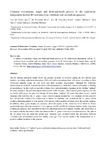Mostrar o rexistro simple do ítem
Common evolutionary origin and birth-and-death process in the replication-independent histone H1 isoforms from vertebrate and invertebrate genomes
| dc.contributor.author | Eirín-López, J.M. | |
| dc.contributor.author | Ruiz Lorenzo, María Fernanda | |
| dc.contributor.author | González-Tizón, Ana M. | |
| dc.contributor.author | Martínez-Lage, Andrés | |
| dc.contributor.author | Ausió, Juan | |
| dc.contributor.author | Sánchez Rodríguez, Lucas | |
| dc.contributor.author | Méndez, Josefina | |
| dc.date.accessioned | 2019-02-11T16:19:18Z | |
| dc.date.available | 2019-02-11T16:19:18Z | |
| dc.date.issued | 2005-09 | |
| dc.identifier.citation | Common evolutionary origin and birth-and-death process in the replication-independent histone H1 isoforms from vertebrate and invertebrate genomes. José M. Eirín-López, M. Fernanda Ruiz, Ana M. González-Tizón, Andrés Martínez, Juan Ausió, Lucas Sánchez, Josefina Méndez, J Mol Evol., (2005), 61(3): 398–407. | es_ES |
| dc.identifier.issn | 0022-2844 | |
| dc.identifier.uri | http://hdl.handle.net/2183/21709 | |
| dc.description.abstract | [Abstract]The H1 histone multigene family shows the greatest diversity of isoforms among the five histone gene families, including replication-dependent (RD) and replication-independent (RI) genes, according to their expression patterns along the cell cycle and their genomic organization. Although the molecular characterization of the RI isoforms has been well documented in vertebrates, similar information is lacking in invertebrates. In this work we provide evidence for a polyadenylation signature in the Mytilus “orphon” H1 genes similar to the polyadenylation characteristic of RI H1 genes. These mussel genes, together with the sea urchin H1δ genes, are part of a lineage of invertebrate “orphon” H1 genes that share several control elements with vertebrate RI H1 genes. These control elements include the UCE element, H1-box and H4-box. We provide evidence for a functional evolution of vertebrate and invertebrate RI H1 genes, which exhibit a clustering pattern by type instead of by species, with a marked difference from the somatic variants. In addition, these genes display an extensive silent divergence at the nucleotide level which is always significantly larger than the nonsilent. It thus appears that RI and RD H1 isoforms display similar long-term evolutionary patterns, best described by the birth-and-death model of evolution. Notably, this observation is in contrast with the theoretical belief that clustered RD H1 genes evolve in a concerted manner. The split of the RI group from the main RD group must therefore have occurred before the divergence between vertebrates and invertebrates about 815 million years ago. This was the result of the transposition of H1 genes to solitary locations in the genome. | es_ES |
| dc.description.sponsorship | Xunta de Galicia; 10PX110304 | es_ES |
| dc.description.sponsorship | Canadá. Canadian Institutes of Health Research; MOP-57718 | es_ES |
| dc.language.iso | eng | es_ES |
| dc.publisher | Springer Nature | es_ES |
| dc.relation.uri | https://doi.org/10.1007/s00239-004-0328-9 | es_ES |
| dc.rights | This is a post-peer-review, pre-copyedit version of an article published in [Journal of Molecular Evolution]. The final authenticated version is available online at: [https://doi.org/10.1007/s00239-004-0328-9]. | es_ES |
| dc.subject | Histone H1 | es_ES |
| dc.subject | Replication-independent genes | es_ES |
| dc.subject | Invertebrates | es_ES |
| dc.subject | Birth-and-death evolution | es_ES |
| dc.subject | Purifying selection | es_ES |
| dc.subject | Orphon genes | es_ES |
| dc.title | Common evolutionary origin and birth-and-death process in the replication-independent histone H1 isoforms from vertebrate and invertebrate genomes | es_ES |
| dc.type | info:eu-repo/semantics/article | es_ES |
| dc.rights.access | info:eu-repo/semantics/openAccess | es_ES |
| UDC.journalTitle | Journal of Molecular Evolution | es_ES |
| UDC.volume | 61 | es_ES |
| UDC.issue | 3 | es_ES |
| UDC.startPage | 398 | es_ES |
| UDC.endPage | 407 | es_ES |
Ficheiros no ítem
Este ítem aparece na(s) seguinte(s) colección(s)
-
GI-GIBE - Artigos [84]






